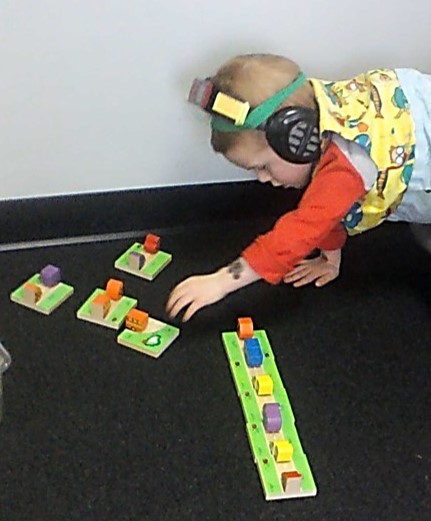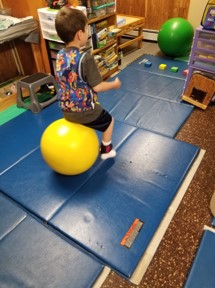Key Issue: Level of Arousal
The Under-Aroused Child
Setting up home program activities for children who have difficulties with self regulation and are Under-Aroused can be a challenge. The seeming lack of interest of the Under Aroused child may often be shown through poor attention to task, limited social skills, or lack of readiness to join in activities. Generally speaking, these children tend to be consistently “under aroused” and bland. They tend to show a lack of response regardless of the situation.
Setting up plans for a home program for children who are Under-Aroused therefore tends to be different from the plans needed for child who is hyperactive. For example, the youngster shown below has taken sitting quietly to a new level.

Although this youngster is sitting quietly, a careful look shows that he is altogether too quiet. The vacant stare indicates that he is not really involved with the environment. His use of furniture to prop up his arm on the back of the chair while his hand props up his head are additional indicators that he is not physically involved with the environment.
This lack of being involved with traditional activities is common for children who tend to be under-aroused. This is a feature that makes home programs for this child a challenge.

In a similar manner, this youngster has been given equipment to initiate an activity. However, he is simply lying on the swing and giving no indication that he is ready to begin doing anything.
The lack of initiating or planning activities that require motor skills tends to be somewhat typical for children who are under-aroused.
Symptoms of being under-aroused often include:
- Under activity
- Tendency to be sedentary
- Lack of initiative in speaking
- Difficulty pacing an activity
- Poor quality of attention
- Failure to use sufficient force
Occupational Therapists have shown that when home programs that incorporate “heavy work” are used throughout the day, under-aroused children are better able to regulate themselves. A surprising feature of “heavy work” is that this strategy seems to work with children who are under-aroused as well as those who are over-aroused.
Unexpectedly, under-aroused children at times fluctuate from being quiet and under aroused to briefly being over-active and noisy. Therefore, home programs that use heavy work activities are helpful when the child flip-flops from one level of arousal to another. This is because heavy work acts to stimulate the ability to produce calming chemicals.
Home programs for children who are under-aroused that incorporate heavy work include important key features.
Key Features of Heavy Work
For example, to have the under-aroused child begin to engage new activities you may want to introduce play with slow movements, darker colors, soft flexible toys, an under-inflated (therefore softer) hop ball, and calm rhythmic music for listening and moving.

Use Steady, antigravity activity such as Physioball walk outs. This boy is lying with his tummy on the ball and walking forward on his hands. The project began with movements that were initially close to his body. However, as the project continued, he had to use extended reach to move the pieces into place.


Use resistive activities, such as pulling and pushing the weight of the whole-body against a stationary boundary. For example:

This girl is sitting on a pillow while pulling on a rope that has been tied around a table leg. She is placing jumbo pegs into a foam pegboard 
This girl is pushing the weight of her body up against gravity as she uses ball walkouts to assemble a track layout.

Use regular, rhythmic body moves, for example using a hop ball while hopping along to the beat of steady music.

This youngster is using the hop ball to ferry one toy car at a time to position the cars as shown on a task card. 
This youngster is using the hop ball to ferry one toy car at a time to position the cars as shown on a task card.
When working with the Under-Aroused child, you will want to gently, but intentionally push forward into use of brighter colors, harder more resistive toys, and more alerting music for listening and moving. This will help the child learn to interact with a more typical range of attention and awareness of the environment.
Need more suggestions on developing a self regulation home program or upper body strength? Check out our blog or this post.

Comments are closed.